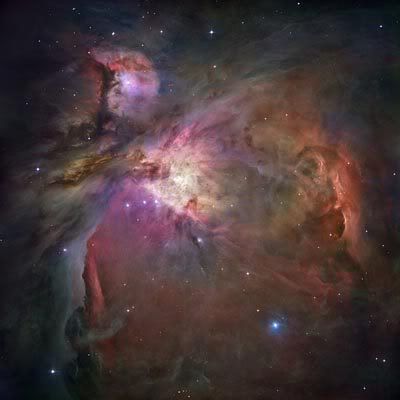
 The brightest star of this constellation, alpha Leo, called Regulus (meaning: the little king), is a blue-white star (spectral type B7 V) of 1.35 mag. When viewed with binoculars or small telescopes a wide companion of 8th mag is revealed.
The brightest star of this constellation, alpha Leo, called Regulus (meaning: the little king), is a blue-white star (spectral type B7 V) of 1.35 mag. When viewed with binoculars or small telescopes a wide companion of 8th mag is revealed.At the tip of the lion's tail the beautiful blue-white main sequence star beta Leo, Denebola is located. Viewed through a telescope beta Leo seems to have an orange companion. But actually the two stars are far away from each other.
Another optical double is tau Leo; the 7th mag companion of this orange 5th mag star can be seen in binoculars.
The binary gamma Leo, called Algieba (the lion's mane), is a magnificent pair, which components consists of a orange-red giant of 2.6 mag brightness and a yellow giant with 3.8 mag. A small telescope is sufficient to split gamma Leo into the single stars. Using binoculars a unrelated 5th mag star, 40 Leo, can be seen next to them.
The binary omega Leo (a 7390) is a very difficult object to resolve. You will at least need a scope with 250mm aperture. The two stars revolve each other with a period of 117 years.
With very low power 54 Leo can easily be resolved into a pair of 4.5 mag and 6.3 mag.
Between eta Leo and gamma Leo the double a 7704 can be found; but to resolve its components into single stars (both are about 7.5 mag) telescopes of at least 100mm aperture are required.
Zeta Leo is an optical triple star of 3.44 mag. Using binoculars this stars seems to have two companions of 6th mag, but they are not physically related together.
The red giant R Leo is a long period variable star. Its brightness varies from mag 4.4 to mag 11.6 (the Bright Stars Catalog gives an average of 6th mag) with a period of about 313 days. It is located in the Lion's foreleg.
For Leo is located far away enough from the dust and the star clouds of the Milky Way the farther away galaxies became visible. There are some interesting galaxies in this region, but they are not easy objects for small telescopes. The three galaxies M65, M66 and NGC 3628 form a conspicuous triple.
The other two Messier objects, M95 and M96 are two fainter spiral galaxies. For more information and observing hints please follow the links to the Messier database.
There is a large number of meteor showers associated with this constellation. The most famous are the Leonids. This shower radiates from the region of gamma Leo and can be seen form November 14-20; the maximum can be observed on November 17th. Although the hourly rate from 10 to 15 meteor seems to be small there is a cycle of about 33 years with an enhanced activity. The next spectacular storm is predicted to take place in 1999.
The shower of the Alpha Leonids was first confirmed by Radio Meteor Project. The duration of this shower cover the period from January 13th to February 13th.
From February 14th to April 25th the Beta Leonids are active. The maximum takes place around March 20th.
Nearly at the same time - from February 2nd to March 19th - the Delta Leonids can be observed. The maximum of the activity peaks at February 22nd.
A rather weak shower are the Gamma Leonids, which are active from August 14th to September 12th with a maximum occuring on August 25th.
The meteor shower of the Rho Leonids seems to be non-existent; yet it has been discovered by radio studies in the 1960's. It seems to be "active" around March 14-15th.
The Sigma Leonids are another storm of doubt. Only one observation has been made.
Detailed information for all meteor showers can be found in Gary Kronk's database about meteor showers.
Source: Seds





3 comments:
Hi ~Z~,hope all is well with you.Just letting you know that I have moved my blog to a new host here is the link; http://bongo69.wordpress.com/ I hope that you are able to get to this one.I am eventually going to be buying my own domain which will be a lot of fun.Hope to hear from you soon!.
Andrew
So how were the 1999 Leoninds?
Hi ~Z~,just giving a shout out to say howdee doo :) .
Andrew
Post a Comment